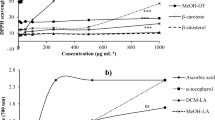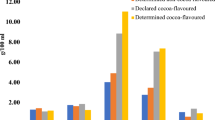Abstract
Coconut testa and tender coconut water (TCW) are by-products of coconut processing industries which are rich in natural phytonutrients, if not exploited properly it may add up to environmental pollution. In the current study, phenolic concentrate (PHE) from coconut testa and tender coconut water (TCW) concentrates were examined for their effect on high fat fed C57BL/6 mice at the level of 50 & 100 mg and 500 & 1000 mg/kg body weight respectively. Results showed increasing body weight in high fat fed animals when compared to starch fed control (ND/SFD) group. Treatment with concentrates of PHE and TCW reduced their body weight dose dependently. Lipid profile like triglycerides, cholesterol and LDL levels were significantly decreased, whereas HDL levels increased, indicating its health beneficial effect. Catalase, SOD, GPx, TBARS in tissues, analysis of OGTT, serum insulin levels, advance glycation and atherogenic protection were augmented at different levels in the treated groups. In conclusion, phenolic concentrate prepared from the coconut testa and tender coconut water concentrate revealed their hypolipidemic property which can be exploited further in the development of health foods.


Similar content being viewed by others
Availability of data and material
Not Applicable.
Code availability
Not Applicable.
References
Adekola KA, Salleh AB, Zaidan UH, Azlan A, Chiavaro E, Paciulli M, Marikkar JMN (2017) Total phenolic content, antioxidative and antidiabetic properties of coconut (Cocos nucifera L.) Testa and selected bean seed coats. Ital J Food Sci 29:741–753
Aebi H (1984) Catalase in vitro. Methods in Enzymol 105:121-126
Akil L, Ahmad HA (2011) Relationships between obesity and cardiovascular diseases in four southern states and Colorado. J Health Care Poor Underserved 22:61–72
Andrikopoulos S, Blair AR, Deluca N, Barbare CF, Proietto J (2008) Evaluating the glucose tolerance test in mice. Am J Physiol Endocrinol Metab 295:1323–1332
Appaiah P, Sunil L, Krishna AG, Kumar GS (2016) Phytochemicals and antioxidant activity of testa extracts of commercial wet and dry coconuts and cakes. Int Res J Pharm 7:9–13
Arumugam M, Raman M, Johnson B, Eagappan K (2014) Dietary fiber isolate from coconut flakes—a functional food. Int J Pharm Sci Rev Res 25:262–267
Ayala A, Muñoz MF, Argüelles S (2014) Lipid peroxidation: production, metabolism, and signaling mechanisms of malondialdehyde and 4-Hydroxy-2-nonenal. Oxidative Med Cell Longev 2014:360–438
Azmah S, Rosli R, Syakroni N (2013) Potential hypoglycaemic property of Albiziamyrophylla and virgin coconut oil in streptozotocin induced diabetic rats. Int J Pharm Sci Rev Res 5:199–202
Bhaskaragoud G, Rajath S, Mahendra VP, Krishna AG, Kumar GS (2016) Hypolipidemic mechanism of oryzanol components—ferulic acid and phytosterols. Biochem Biophys Res Commun 476:82–89
Chikezie CM, Ojiako OA, Emejulu AA, Chikezie PC (2018) Atherogenicity of diabetic rats administered single and combinatorial herbal extracts. Bull Fac Pharm 56:169–174
Chowdappa P (2016) Virgin coconut oil- Hot and fermentation process. Techical bulletin No. 108, Published by ICAR- Cental Plantation Crops Research Institute, Kerala
Flohe L, Günzler WA (1984) Assays of glutathione peroxidase. Method Enzymol 105:114–121
Flohe L, Otting F (1984) Superoxide dismutase assays. Method Enzymol 105:93–104
Folch J, Lees M, Stanley S, Sindhe GH (1957) A simple method for the isolation and purification of total lipids from animal tissue. J Bio Chem 226:497–509
Griffiths DW (1986) The Inhibition of digestive enzymes by polyphenolic compounds. In: Friedman M (ed) Nutritional and toxicological significance of Enzyme Inhibitors in Foods. Plenum press, New York, pp 509–516
Iranloye B, Oludare G, Olubiyi M (2013) Anti-diabetic and antioxidant effects of virgin coconut oil in alloxan induced diabetic male Sprague Dawley rats. J Diabetes 3:221–226
Kumar MV, Sambaiah K, Lokesh BR (2000) Hypocholesterolemic effect of anhydrous milk fat ghee is mediated by increasing the secretion of biliary lipids. J Nutr Biochem 11:69–75
Pillon NJ, Soulage CO (2012) Lipid peroxidation by-products and the metabolic syndrome. In: Catala A (ed) Lipid peroxidation. Intech Open, London, pp 409–436
Rael LT, Thomas GW, Craun ML, Curtis CG, Bar-Or R, Bar-Or D (2004) Lipid peroxidation and the thiobarbituric acid assay: standardization of the assay when using saturated and unsaturated fatty acids. J Biochem Mol Biol 37:749–752
Reena MB, Gowda RL, Lokesh BR (2010) Enhanced hypocholesterolemic effects of interesterified oils are mediated by upregulating LDL receptor and cholesterol 7-α-hydroxylase gene expression in rats. J Nutr 141:24–30
Schmidt AM, Hasu M, Popov D, Zhang JH, Chen J, Yan SD, Brett J, Cao R, Kuwabara K, Costache G (1994) The receptor for advanced glycation end products (AGEs) has a central role in vessel wall interactions and gene activation in response to AGEs in the intravascular space. Proc Natl Acad Sci 91:8807–8811
Siddalingaswamy M, Rayaorth A, Khanum F (2011) Anti-diabetic effects of cold and hot extracted virgin coconut oil. J Diabetes 1:118–123
Tabak AG, Jokela M, Akbaraly TN, Brunner EJ, Kivimäki M, Witte DR (2009) Trajectories of glycaemia, insulin sensitivity and insulin secretion before diagnosis of type 2 diabetes: an analysis from the Whitehall II Study. Lancet 373:2215–2221
Tan KCB, Shiu SWM, Wong Y, Tam X (2011) Serum advanced glycation end products (AGEs) are associated with insulin resistance. Diabetes-Metab Res 27:488–492
Victor E, Jeroh E (2012) Anti diabetic effects of the Cocos nucifera (Coconut) husk extract. J Med Appl Biosci 4:16–18
Acknowledgements
The authors would like to thank the Director, CSIR-Central Food Technological Research Institute, Mysuru, to carry out the research work and providing the required infrastructure and other facilities. The authors also acknowledge the support of Dr. A.G. Gopalakrishna, Retired Chief Scientist & Dr. R. Chetana, TFSS department for their valuable inputs for the research carried out in this study and provided the writing assistance.
Funding
The present research study was funded by Coconut Development Board, Kochi, Kerala, India.
Author information
Authors and Affiliations
Contributions
ASMK and VG, involved in planning the experiments, execution of experiments, generating the data, statistical analysis of results, manuscript writing. The corresponding author GSK, contributed in planning, analysing and interpretation of the results followed by manuscript finalization for publication.
Corresponding author
Ethics declarations
Conflicts of interest
All authors declare that there is no conflict of interest in this Manuscript.
Ethics approval
The animal experimental studies were carried out in the institutional animal house facility using male C57BL/6 mice and had clearance from IAEC (#296/2014), CSIR-CFTRI, Mysuru, India.
Consent to participate
Not Applicable.
Consent for publication
Not Applicable.
Additional information
Publisher's Note
Springer Nature remains neutral with regard to jurisdictional claims in published maps and institutional affiliations.
Rights and permissions
About this article
Cite this article
Kumar, A.S.M., Geetha, V. & Kumar, G.S. Impact of phenolic concentrate from tender coconut water and coconut testa on high fat cholesterol fed C57BL6 mice. J Food Sci Technol 59, 1299–1306 (2022). https://doi.org/10.1007/s13197-021-05138-w
Revised:
Accepted:
Published:
Issue Date:
DOI: https://doi.org/10.1007/s13197-021-05138-w




